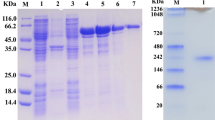Abstract
Previously, AoamyA, the alpha amylase-encoding gene from Aspergillus oryzae, was heterologously expressed in Monascus ruber CICC41233 to promote starch hydrolysis and increase the production of Monascus pigments. The target of this study is to screen the effective alpha-amylases from M. ruber for starch fast degradation and investigated for Monascus pigments production. The 13 types of predicted alpha-amylases in the M. ruber NRRL1597 genome were divided into four classes based on EC number and into five groups based on the glycoside hydrolase sub-family. The predicted alpha-amylases MrAMY1 (protein ID 440333) and MrAMY2 (protein ID 324551) showed the closest match with AOamyA by phylogenetic analysis. The genes encoding alpha-amylase, Mramy1and Mramy2, were cloned from M. ruber CICC41233. However, the gene sequence of Mramy1 from M. ruber CICC41233 differed from that of M.ruber NRRL1597 in the length of the intron sequence. Furthermore, the Mramy1-overexpressed strain M.ruber 440333-6A completely degraded the starch of rice grain in 2 d; in contrast, starch (40.32 mg/mL) remained when rice grain was incubated with the Mramy2-overexpressed strain, M. ruber 324551-D even after 2 d, while 45.43 mg/mL and 10.48 mg/mL starch remained after 2 d and 6 d, respectively, in wild type M. ruber CICC41233. Compared to that of M. ruber CICC41233, the total Monascus pigments and ethanol-soluble pigments in M.ruber 440333-6A increased by 71.69% and 119.33% after 6d, respectively; however, it decreased by 21.40%and 26.58% after 6d, respectively, in M. ruber 324551-D. This study demonstrated that alpha-amylase MrAMY1 was superior to MrAMY2, as it effectively degraded the starch of rice grain and enhanced Monascus pigments production.


Similar content being viewed by others
References
Balakrishnan BJ, Karki S, Chiu SH, Kim HJ, Suh JW, Nam B, Yoon YM, Chen CC, Kwon HJ (2013) Genetic localization and in vivo characterization of a Monascusazaphilone pigment biosynthetic gene cluster. Appl Microbiol Biotechnol 97:6337–6345
Chen WP, He Y, Zhou YX, Shao YC, Feng YL, Li M, Chen FS (2015) Edible filamentous fungi from the species Monascus: early traditional fermentations, modern molecular biology, and future genomics. Compr Rev Food Sci Food Saf 14:555–567
Chen WP, Chen RF, Liu QP, He Y, He K, Ding XL, Kang LJ, Guo XX, **e NN, Zhou YX, Lu YY, Cox RJ, Molnár I, LiM Shao YC, Chen FS (2017) Orange, red, yellow: biosynthesis of azaphilone pigments in Monascus fungi. Chem Sci 8:4917–4925
Dufossé L, Galaup P, Yaron A, AradSM BP, Murthy KNC, Ravishankar G (2005) Microorganisms and microalgae as sources of pigments for food use: a scientific oddity or an industrial reality? Trends Food Sci Tech 16(9):389–406
Feng Y, Shao Y, Chen F (2012) Monascus pigments. Appl Microbiol Biotechnol 96(6):1421–1440
Kang B, Zhang XH, Wu ZQ, Wang ZL, Park S (2014) Production of citrinin-free Monascus pigments by submerged culture at low pH. Enzym Microb Technol 55:50–57
Long CN, Liu MM, Zhang DS, **e SB, Yuan WY, Gui N, Cui JJ, Zeng B (2018) Highly efficient improvement of Monascus pigment production by accelerating starch hydrolysis in Monascusruber CICC41233. 3 Biotech 8(329):1–7
Long CN, Liu MM, Chen X, Wang XF, Ai MQ, Cui JJ, Zeng B (2018) The acyl-CoA binding protein affects Monascus pigment production in Monascusruber CICC41233. 3 Biotech 8(2):1–8
Mostafa ME, Abbady MS (2014) Secondary metabolites and bioactivity of the Monascus pigments review article. Global J Biotech Biochem 9(1):1–13
Patakova P (2013) Monascus secondary metabolites: production and biological activity. J Ind Microbiol Biotechnol 40:169–181
Puttananjaiah MKH, Dhale MA (2012) Glucose released by hydrolytic activity of amylase influences the pigment synthesis in Penicilliumsp NIOM-02. J Basic Microbiol 52:1–5
Shao YC, Lei M, Mao ZJ, Zhou YX, Chen FS (2014) Insights into Monascus biology at the genetic level. Appl Microbiol Biotechnol 98:3911–3922
Shi K, Song D, Chen G, Pistolozzi M, Wu Z, Quan L (2015) Controlling composition and color characteristics of Monascus pigments by pH and nitrogen sources in submerged fermentation. J Biosci Bioeng 120:145–154
Vendruscolo F, Bühler RMM, de Carvalho JC, de Oliveira D, Moritz DE, Schmidell W, Ninow JL (2016) Monascus: a reality on the production and application of microbial pigments. Appl Biochem Biotechnol 178:211–223
**e N, Liu Q, Chen F (2013) Deletion of pigR gene in Monascusruber leadsto loss of pigment production. Biotechnol Lett 35(9):1425–1432
Yang Y, Liu B, Du XJ, Li P, Liang B, Cheng XZ, Du LC, Huang D, Wang L, Wang S (2015) Complete genome sequence and transcriptomics analyses reveal pigment biosynthesis and regulatory mechanisms in an industrial strain, Monascuspurpureus YY-1. Sci Rep 5(8331):1–9
Acknowledgements
This work was funded by the National Natural Science Foundation of China (grant nos. 31860436, 31171731, 31460447), Natural Science Foundation of Jiangxi Province (grant nos. 20161BAB214177, 20181BAB204001), Science and Technology Research project of Jiangxi Provincial Education Department (grant no. GJJ170676), and Youth Top-notch Talent project of Jiangxi Science and Technology Normal University (grant no. 2018QNBJRC004).
Author information
Authors and Affiliations
Corresponding author
Ethics declarations
Conflict of interest
The authors declare that they have no competing interests.
Electronic supplementary material
Below is the link to the electronic supplementary material.
Rights and permissions
About this article
Cite this article
Long, C., Cui, J., **e, S. et al. The alpha-amylase MrAMY1 is better than MrAMY2 in rice starch degradation, which promotes Monascus pigments production in Monascus ruber. 3 Biotech 10, 45 (2020). https://doi.org/10.1007/s13205-019-2026-8
Received:
Accepted:
Published:
DOI: https://doi.org/10.1007/s13205-019-2026-8




